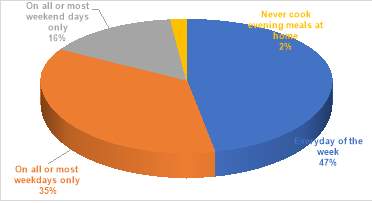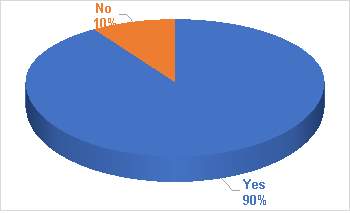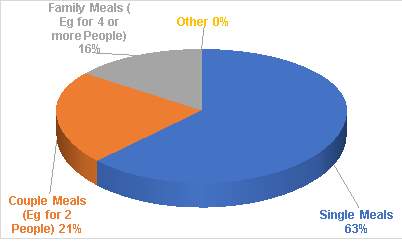Frozen Ready Meal Consumer Purchase Decisions
Info: 10922 words (44 pages) Dissertation
Published: 3rd Sep 2021
Chapter One: Introduction
The main purpose of this dissertation was to examine selected product attributes and demographic variables that affected consumer repurchase decision on frozen ready to eat meals. It is prepared based on the idea of the establishment of a business of Frozen ready meal in Invercargill, New Zealand. This report is prepared as a document of a business proposal that is useful in case of collecting funds from owners and bank loan as well as providing an operational plan for the operation of this business.
1.1 The Business Concept
Frozen Meal is considered to be one of the largest segment of the overall food industry, and is anticipated to grow robustly due to increasing acceptance by global consumers (Sun, 2012, p. XIII). Ready to Eat Meals, also known as “convenience food” is commercially prepared food, designed for easy to consume and fast. In Invercargill, New Zealand a state of the art Central Kitchen will be established. At the central kitchen, the food will be prepared oven cooked, pre-portion and then Blast Frozen to keep its taste and quality in accordance with Food Act 2014 (www.mpi.govt.nz/foodact, 2016). The products are sold through retail supermarkets, online store and vending machines. The estimated shelf life of the products is about 12 months’, but the products must be Blast Frozen in accordance to Hazard Analysis Critical Control Point (HACCP). The quality of frozen food depends fundamentally on the quality of raw materials used and product manufacture but can be jeopardised by a failure to maintain product temperature at -18oC. A suitable low level in any part of the supply chain, including storage, transport, distribution, and display in retail stores (Industries, 2014).
There is a rising demand for quick and nutritious meals with minimal preparation time. As people are getting busier, they now depend on a ready meal for the best quality of food in their home. The business concept is built on the assumption that today, more food preparation is being performed by food manufacturers and less at home. This development has been facilitated by the use of technological innovations in freezing, packaging and by the use of microwaves (Senauer, Asp, & Kinsey, 1998).
1.2 The value the business will provide to customers
The value for the customer is that the meals will be easy to prepare when the customer needs to eat. The proposed product can either be put in a microwave oven to warm immediately before severing, or placed in heated water for a few minutes and then served. In a study by Costa, Schoolmeester, Dekker, & Jongen, 2003, pp. 1-2, consumers expressed their beliefs about ready meals. Positive feelings towards ready-meal consumption were associated with being relaxed and spending less time and energy on cooking. (Costa, Schoolmeester, Dekker, & Jongen, 2003, pp. 1-2)The value the business will provide are 100% natural, convenient, quality and taste of food, value for money, easy availability, and free delivery to New Zealand wide. During the 1960s, households prepared most of their food and consumed it at home. Nowadays, more food preparation is done by food manufacturers. Food manufacturers have been able to provide customers with more foods with less preparation time. This development has been facilitated by the use of technological innovations in freezing, packaging and by the use of microwaves (Senauer, Asp, & Kinsey, 1998). The channels section defines how the business communicates with, and provides value to its chosen customer segment there are retail outlets, where it will be in all major supermarket all around New Zealand.
1.3 The purpose of the dissertation
The choice of the research has been defined due to a number of reasons. First, the customer behaviour is the study of human beings. It is to know people’s purchase decision. The customers differ from each other by income, age, education, lifestyle, character, and all this influences their purchasing decisions (Kotler, 2012, pp. 159-175). For this reason, the author felt the studying the field of consumer behaviour as interesting and challenging. The author also examines the relationship between attributes such as taste, price, packaging and preparation times to purchase frozen Ready to Eat Meals.
The purpose of this study is to examine the behaviour of New Zealand consumers towards consumption of a frozen ready meal. The study will provide information regarding frozen ready meal buyers’ behaviour, assuming that the knowledge provided would assist the author to produce a frozen ready meal in the implementation of its marketing decisions. From the research background, there is various factors influencing consumer behaviours. In addition, there are different approaches for studying consumer behaviour. The present study of consumer behaviour was conducted from the point of view of understanding consumption behaviour, and strategies are most appropriate in order to establish a successful Frozen Ready to Eat Meal business to supply New Zealand markets. The implementation of this research was limited to a specific period of time, place, products and target groups. For this reason, the findings of the present research cannot be fully generalised. To understand the whole consumption pattern, there is a need for deeper analysis and research on a larger scale.
1.4 The objectives of the research
The objectives of the research are:
1. To differentiate the potential market for Asian cuisine Frozen Ready to Eat (RTE) meals for different types of consumers.
2. To examine the relationship between attributes such as taste, price, packaging and preparation times and consumer decisions to purchase frozen RTE meals.
3. To establish whether there is a demand or market opportunity to distribute frozen RTE Asian cuisine in New Zealand.
4. To formulate marketing strategies to make Asian cuisine frozen RTE meals successful in New Zealand markets.
5. To establish the market niche and point of difference for a new RTE meal on the New Zealand market.
The questions that the research seeks to answer are as follows:
1. What are the product attributes and demographic variables that affect consumer purchase decisions about Frozen Ready to Eat meals?
2. What is the market opportunity of frozen RTE meals in New Zealand?
3. What are the relative impacts of product attributes such as taste, price, packaging, preparation time on consumer purchase decisions?
4. What strategies are most appropriate in order to establish a successful frozen RTE cuisine business to supply New Zealand markets?
Chapter Two: Literature Review
2.1 Introduction
This chapter summarises and synthesizes the literature that has been published relating to the frozen food industry, with a particular focus on the New Zealand markets. The frozen food industry is undergoing rapid and exponential expansion. Retail grocery stores and frozen food suppliers are interested in promoting frozen foods The Literature review explains the concept of Frozen Ready to Eat (RTE) meals in general, and the development of the industry in New Zealand. It summarises what has been published about the pricing, packaging, purchase decision, trends, technological and demand for frozen RTE meals in New Zealand.
RTE meals are for people who are too busy, unwilling or even unable to prepare their own food. As Bennett (2014) states, the total market will continue to grow due to increasing demand for easy to prepare meals because more working couples and consumers are spending less time on food preparation. Convenience food has been defined as food offered to the consumer in such a manner that purchase, preparation and consumption of a meal costs less physical and mental effort or money than when the original or separate components are used (Luning & Devlieghere, 2006). The literature notes that the New Zealand food and beverage industry is one of the most competitive and dynamic in the world driven by consumers seeking greater diversity, quality and value in their food and beverage choices (Bennett, 2014, p. 38). Bennet describes the ready to eat meal industry in New Zealand as consisting of two categories: frozen ready meals and canned ready meals. The ready meals market in grocery is worth $709 million and is split into frozen ready meals (86% share/$612 million), chilled ready meals (9%/$66 million), and shelf-stable ready meals (5%/$31 million), representing a compound annual growth rate (CAGR) of 2.4% between 2010 and 2014 (Bennett, 2014, p. 38). This is further supported by MarketLine (2015, pp. 18-22) in its statement that frozen ready meals are the largest segments in the New Zealand market, and they are also the fastest-growing (MarketLine, 2015, pp. 18-22).
New Zealand’s food industry has changed significantly to adapt to the demands and lifestyles of domestic consumers, particularly the growing middle class. Marketline (2015, p. 33) considers that is also due to the rapid expansion of the retail distribution system such as modern supermarkets, superstores and convenience stores (MarketLine, 2015, p. 33). RTE are currently the most rapid growth product categories in the domestic market (MarketLine, 2015, p. 14). The literature on the state of RTE market in New Zealand supports the researcher’s research question about the influential factors determining the market such as price, packaging, preparation time, purchase decision, and technological advancement in frozen food industry. The main aim for this study is to explore market potential for frozen ready to eat products and the major forces determining the segment to grow and the future potential of the industry.
2.2 Price
Another key issue noted in the literature is what customers are willing to pay more for frozen meals. Chanjin, Samuel, & Myers (2008, pp. 276-296) provide an empirical analysis of grocery store shopping behaviour and prices across inner city or suburban areas. Their work indicates the biggest factor contributing to buying behaviour in grocery stores was the price and convenience of frozen foods that were preferred over traditional forms of grocery purchase. The literature notes that a key attribute of any product is price; however, as noted by Garton (1995, pp. 29-35), buyer behaviour is influenced by a wide range of factors including the price of product, product developments and customer assistance. As explained by Garton (1995, pp. 29-35), price also refers to a reasonable price, which customers will compare against the service that they receive . Price is a marketing tool that can be used to help attract customers, create customer satisfaction and build customer loyalty (Garton, 1995, pp. 29-35). Dawson (1995, pp. 4-20) also argues that the search for price and price comparisons are responsive to consumer buying behaviour. Kotler (2013 pp. 354-360) also pointed out that industry players would have to significantly improve their price competitiveness. Besides the price, the variety of product range offered by industry players will have to be strengthened (Kotler, Burton, Deans, Brown, & Armstrong, 2013). The pricing of a product is important to formulate marketing strategies to make frozen RTE meals successful in New Zealand markets and also to establish the market niche and point of difference for a new frozen RTE meal on the New Zealand market in accordance to the research objective.
2.3 Packaging
Packaging is a perfect illustration of the principle that attributes can have sub-attributes. The finished product has form attributes such as shape, size, weight and texture (Parry, 2001). According to Frozen Food Packaging Industry Study with Forecasts for 2013 to 2018 (The Freedonia Group 2010, p. 4), demand for frozen food packaging is projected to climb 3.7% per year to $6.8 billion in 2013, driven by the acceptance of convenience type foods, both among customers and foodservice establishments; the use of microwave ovens, and technological advances in packaging (The Freedonia Group, January 2010, p. 4). The growing demand for ready-to-eat meals will in turn use of more packaging products will boost the growth of the overall market over the next four years (2016 to 2020). Increased demand among customers and retailers for flexible packaging materials such as plastic films and vacuum pouches will also contribute to the market growth (Technavio Research, Febuary 2016). Also, the use of case-ready packaging to reduce expenditure on labour-related operations such as cutting, sorting and grading of products will help the market grow further (Technavio Research, Febuary 2016). Consequently, packaging design often has to stand for the appearance of the food itself. Moreover the appearance and the packaging are powerful forces in customer purchase decision because the customer can see how the food looks like on the packaging.
2.4 Preparation Time
Preparation time is important in frozen RTE meals, given that customers buy them because they are easy to prepare. Preparation timetherefore plays a role towards the purchase decision food, as saving time is at the heart of the reason why consumers pick products such as RTE meals and other pre-packaged products (Darian, 1995, pp. 32-44). The increasing demand for convenience-orientated food derives from consumers who have limited time (Berry, 1979, pp. 58-69). Participants in a study by Darian (1995, pp32-44) were described as busy working people with limited time. They agreed that, working people have no time and that they buy fast foods, frozen dinners because they were convenient (Darian, 1995, pp. 32-44). A study has shown that the employed women feel that they do not have time but that they do not purchase any more time-saving goods and services than others. According to Darian (1995, pp. 32-44), people who are busy are willing to use fast foods because benefits of high convenience outweigh other factors such as healthiness (Darian, 1995, pp. 32-44). Preparation time is crucial because consumer buys Frozen Ready to Eat Meals due to convenience easy and fast to prepare. The preparation time is also vital part of customers purchase decision because consumer who purchase does not time the time.
2.5 Purchase Decision
There are product attributes and choice that influence the choice to purchase frozen RTE meals. The findings of an investigation into the chilled ready meal market in Northern Ireland (Reed, McIlveen, & Strugnell, 2000, pp. 234-241) showed that convenience was the dominant motive for the purchase of the product, satisfying the consumer requirement for added value food products. Silayoi and Speece (2004, pp. 607-628) used focus groups in order to gain in-depth insights into consumer shopping behaviours for packaged food products. The results show packaging elements are the main factors in respondent assessment and decisions on packaged food purchasing (Silayoi & Speece, 2004, pp. 607-628).
2.6 Trends
Recent trends in the frozen RTE meal market in New Zealand indicate current opportunities and challenges for potential new businesses entering the market. According to market research firm Roy Morgan Research (2014, p. 9), the frozen RTE meals market is dominated by the companies McCain, Simplot and Matchlow. However, it notes the growing private label push by local supermarket brands which it argues could hurt the traditional branded players (Roy Morgan Research, 2014, p. 9). RTE meals have gained momentum in New Zealand, driven by factors such as: an ageing population; people who are time-poor; a desire for convenience; and more women entering the paid workforce (Roy Morgan Research, 2014, p. 9). It reports that in the year to March 2010 8.1% of surveyed aged 14 and over said they had eaten a frozen or chilled ready-prepared meal in the previous seven days, whereas by the year to March 2014, this figure had risen to 9.4%, an increase of about 373,000 people (Roy Morgan Research, 2014, p. 9). Of those respondents who did not have time to cook, 15.7% reported eating at least one frozen meal in an average seven days; up from 13.1% in the year to March 2010 (Roy Morgan Research, 2014, p. 9). The increasingly hectic lifestyles were highlighted by research which showed that only one-third of families manage to sit down for dinner every night (Roy Morgan Research, 2014, p. 9).
2.7 Technological
Technological advancement is very important in the frozen food industry because without the proper equipment for example the blast freezer the frozen food industry cannot be done. Clarence Birdseye, an American inventor in the 20th century, was the first to develop blast freezing technology that preserved both taste and appearance. The concept is that, when food is frozen fast, large ice crystals are unable to form, hence the name of the technology “quick-frozen“ or “blast frozen”. In the normal process of freezing, large ice crystals are formed that can damage and destroy the flavour and texture of foods (Archer, 2004, pp. 127-138). If these ice crystals are unable to form, the frozen food will maintain its maximum flavour, texture, and colour after thawing (Barbosa-Cánovas, Altunakar, & Mejía-Lorío, 2005, pp. 1-36). The advances in freezing technologies have since been complemented by refrigerator displays in supermarkets and better and faster supply chain solutions, all a response to the increasing consumption and therefore growing demand for frozen foods (Senauer, Asp, & Kinsey, Food Trends and the Changing Consumer, 1998, p. 15). As Senauer, Asp and Kinsey (2008, p. 18) note, these factors make it necessary, “for frozen foods producers to offer a greater variety of convenience foods, new product launches and intelligent product positioning. Customers are getting more aware that frozen food can, in many cases, be a better alternative for convenient lifestyle. There are a demand growing in supermarkets with more space allocated for frozen products.”
According to Senauer, Asp and Kinsey (2008, p. 20), increasing awareness of healthy eating continued in the 1990s, with people becoming more concerned about preservatives in their food. People are willing to pay more for healthier products that used higher quality ingredients. Nowadays more food preparation is being performed by food manufacturers and less at home due to work commitment. Food manufacturers have been able to provide consumers with more foods where much of the preparation work has been done outside the home. This development has been facilitated by the use of technological innovations in freezing, packaging and by the use of microwaves (Senauer, Asp, & Kinsey, Food Trends and the Changing Consumer, 1998, p. 22).
2.8 Conclusion
From the review of relevant literature, there is a demand to distribute Frozen Ready to Eat Meals in New Zealand. An increasing demand for frozen foods already exists, due to the fact that a growing number of consumers do not have time to cook their meals at home. Frozen RTE meals now have quality in both process techniques and products. Therefore, improvements can only be achieved by focusing research on new market trends that are discussed here that influence the quality of frozen meals. This has led to a change in the food sector as it is witnessing a shift in consumption patterns, especially regarding frozen RTE meals. Frozen Ready to Eat Meals more value for money in termsfs of quality and variety. Therefore, considering all the issues raised in this literature review there is a demand in frozen ready to eat meals in New Zealand. The researcher concluded that there is a potential business that can be developed in this New Zealand market.
Chapter Three: Methodology
3.1 Introduction
This section of the report sets out the methodology used to carry out the research including a description of the methods used to collect and analyse data. According to Saunders, Thornhill, and Lewis (2009, p. 674) the research methodology encompasses the theory of how research should be undertaken, including the theoretical and philosophical assumptions upon which research is based and the consequences of these for the method or methods adopted. The objective of this research was to investigate the feasibility of starting a frozen food business in Invercargill, New Zealand. It is aimed to examine the relationship between attributes such as taste, price, packaging and preparation times and consumer decisions to purchase Frozen RTE meals and to establish whether there is a demand or market opportunity to distribute frozen RTE Asian cuisine in New Zealand, as well as to formulate marketing strategies.
The research undertaken was applied research: that is, research aimed at finding a solution for an immediate problem facing the business organisation. The researcher carried out applied research to resolve an existing business problem, to find out relevant information to enable the successful introduction of a new RTE product in the New Zealand frozen food industry. The researcher used mixed methods to arrive at a positive outcome. The researcher used quantitative research method for the potential participant questionnaire and the second method for content analysis is to analyse online content. The researcher has encountered qualitative data and quantitative data while analysing this method.
Quantitative research is to get people’s perception and thoughts it is used to quantify attitudes and opinions. The researcher has used both the method questionnaire to potential customers and content analysis of potential competitor products. The questionnaire and content analysis will allow the researcher to triangulate and using two methods to gather data about the market potential the researcher more confidence and reliability of the data. The tools used to conduct the research methodological approach will answer the research question and meet the objectives. The Research about the ready meal business was done considering the questionnaire and content analysis methods. The respondents are provided different questionnaire then the data were collected both in the numerical and qualitative form. So, the research was done in the mixed methods.
- Printed survey Potential Buyers of Frozen Ready to Eat Meals at supermarkets
- Content Analysis – Analyse online supermarket, for example, online web page of Countdown and online web page of New World Levin.
3.2 Method 1 Questionnaire
3.2.1 Purpose of Questionnaire
The purpose of the questionnaire was to collect quantitative and qualitative data relating to consumer decisions to purchase Frozen RTE meals. For this study, the researcher spent time in the frozen food sections of Invercargill supermarkets at a different time during the day with the aim of recruiting participants from various segment of the shopping population. Shoppers were invited to complete a questionnaire and were given the form to fill out and return to the researcher. The questionnaires on the survey were designed with an additional option open-ended question in the questionnaires so that respondents can provide comments and thoughts. The open-ended question asks the respondents if they have any suggestions or comments on RTE Meals.
3.2.2 Questionnaire Design
The author tried to design the questionnaire in such a way that it would be interesting, and easy to complete for respondents (Please refer Appendix My Chef survey.pdf). The questionnaire was constructed with the assistance of the dissertation supervisor.
The majority of questions designed were close-ended questions, with one open-ended question. The question format consisted of five rating scales that measured the intensity of agreement with provided statements, and multiple choice, check box and matrix type questions. The questionnaire was divided into three main parts. Part 1 was questioned on the potential market for Asian cuisine frozen Ready to Eat (RTE) meals for different types of consumers. Part 2 focused on factors influencing consumer behaviour towards taste, price, packaging and preparation times and consumer decisions to purchase RTE meals. One open-ended questions are asked if they have any suggestions or comments on RTE Meals.
Part 3 asked respondents about their gender, age, income, and whom they were buying for. It was decided to give out questionnaires in the supermarket in order to increase the response rate and to ensure that the questionnaire targeted the appropriate participants: supermarket shoppers who represented the target customers of the proposed business concept.
3.2.3 Pilot Study
A pilot study is conducted to make sure the survey questions operate well and function as expected (Bryman & Bell, 2011). Before using the questionnaire to collect data, it was tested to assure the validity of its content. The purpose of the testing was to refine the questionnaire so that respondents would not have difficulties in answering questions and there would not be problems in recording the data. The survey was printed out, and five people representative of the potential participants were invited to complete it. The pilot respondents included a range of different people including two tertiary students, one working person and one retirement-aged person; this is to represent the broad range of participants that the researcher was seeking.
3.2.4 How Method are carried Out
The researcher decided to go to local supermarkets in around Invercargill. The researcher has gone to six supermarkets but only got two consent from the manager to do the survey at their premises. One of the supermarkets gave the researcher the consent to fill the questionnaire in the frozen section of the supermarket while the participant bought the frozen food. The other supermarket only gave permission to do the questionnaire at the car park.
3.2.5 Sampling
According to Kothari (1996) sampling indicates the selection of a group or an aggregate with the view to obtaining information about the whole. Sampling is an integral part of a research design (Kothari, 1996). The researcher wanted to know the research population who purchase RTE meals. The researcher has gone to the different supermarket to understand the purchase decision. The size of the sample was determined to be 120 participants that represented the population. The researcher sought a diversity of participants to represent a spectrum of potential customers, including tertiary students, working individuals, and retired people. The researcher went to local supermarkets at a different time during the day to access different segments of the participant.
The sampling method used was non-probability, convenience sampling. According to Ghauri and Gronhaug, a non-probability sample is a sample that is not selected using a random selection method (Ghauri & Gronhaug, 2005, p. 147). There is a significant non-response rate when this type of survey is conducted. For this reason, people who refused to participate in the survey and complete questionnaires at the first attempt were excluded from the sample. The sample design was chosen on the basis of convenience in accessing a sample that was representative of the target population.
3.2.6 Analysis Method
After the data for this research was collected, the information obtained was analysed, and conclusions were drawn. The findings of this study are presented in the section of the research result. The analysis was implemented with the help of Microsoft Excel. The data obtained from surveys first was coded and quantified; then the responses were tabulated and analysed.
3.3 Method 2 Content Analysis
3.3.1 Purpose of Content Analysis
Content analysis is a research technique used to make replicable by interpreting and coding textual material. By steadily evaluating texts, documents, oral communication, websites and graphics qualitative data can be converted into quantitative data. (Nachmias & Nachmias, 1976). The purpose of using content analysis as the second data collection method was to understand the range of Frozen RTE meals sold by New Zealand supermarket. This was done by carrying out an analysis of the Frozen RTE meals offered for online supermarket shopping via the supermarket websites. Content analysis was particularly useful for collecting information on what products are currently available in the market, including their pricing, packaging, the size of servings and range of flavours.
3.3.2 Sampling
The objective of the content analysis is to establish whether there is a demand or market opportunity to distribute frozen RTE Asian cuisine in New Zealand and to get valuable insight on the frozen food industry in the region. The researcher chose two supermarkets with local online presence: Countdown at https://www.countdown.co.nz and New World Levin at https://shop.newworld.co.nz/store/72C670037. The researcher prepared an Excel sheet to see the difference between Asian meals and other meals that are sold in those online stores. The researcher analysed these attributes such as the price, net weight, eat on existing pack, the size of servings, cooking method, halal, organic, vegetarian, gluten free, weight watches, time to prepare, a country of origin and packaging design. These factors were chosen as important because to know what the competitors offer and how the researcher can add value to the proposed business.
3.3.4 Analysis method
After the data for this research was collected, the information obtained was analysed, and conclusions were drawn. The findings of this study are presented in the results section below. The analysis was implemented with the help of Microsoft Excel. The data obtained from content analysis first was coded and measured; then the content was tabulated and analysed. The researcher analyses the information which is used to interpret the result.
3.4 Conclusion
The researcher has done extensive research for this dissertation. The researcher has used two methods the survey and content analysis for this research dissertation. By using this two methods, the researcher will have a better understanding and will answer the research questions and research objectives. The researcher is also aware of the bias from sampling methods that was used, may affect the survey outcome. This is because the researcher has mostly closed-ended questions this will not give respondents any option to give any other opinion. Now the researcher has provided comprehensive coverage of the research methods; the researcher will now turn to identify and describe any ethical concerns with this research project.
Chapter Four: Ethical and Cultural Considerations
Problems surrounding ethics was another possible limitation of the research due to the close contact the researcher had with the respondents and the interactive nature of the research that aimed to extract personal opinions and perceptions. The issues of privacy and betrayal of trust is a real possibility when researchers invade the ‘personal space’ of respondents. Veal (1997) cites honesty and respect for rights of individuals as universal principles of ethics which when adopted in research, should minimise the occurrence of problems (Veal, 1997). Bouma (2000) emphasises the importance of sending a letter of introduction to respondents which will help to identify the researcher and secure the cooperation of respondents with the proposed research (Bouma, 2000). Therefore, a covering letter was used in this research to identify the researcher and to explain how the anonymity of participants would be ensured. The participants were assured of their anonymity in relation to the sharing of the information.
The identity and personal information of participants are not disclosed unless they agree. In this study, the individual cases were coded and in the dissertation, are only referred to by their codes. None of the interview transcripts that might enable participant identification is included and the email correspondence with participants is similarly not included.
To ensure these ethical principles, as previously mentioned the researcher coded the names of participants. In addition, when contacting all participants, the researcher has put in the covering letter the sentence that everything will be confidential and it will not be used for anything other than the study aim and all personal data will be kept secret. Furthermore, the researcher provided all participants with the information about the research and its aims. The researcher was given permission from all of them to collect data using different instruments and to audio-record the interview and video-record the observation. The right of participants to withdraw from the study and not to answer any sensitive questions was emphasised.
All survey and interview tapes were labelled according to the pre-determined codes, and are stored in a lockable filing cabinet and will be destroyed in accordance to SIT ethics. The research proposal was subject to SIT ethics in research policy process, whereby ethical procedures were stipulated and followed throughout the research process with procedures implemented to protect the anonymity of individual respondents. It was through this process that problems of ethics were minimised. And after the publishing of my report, it will be destroyed safely. I will follow SIT’s ethics in research project declaration of consent & non-disclosure of information that is layout by Southern Institute of Technology.
Chapter Five: Results
5.1 Introduction
In this chapter, the researcher reports the research findings and analyses the findings. The researcher used multiple quantitative methods to gather data: a questionnaire to potential customers and a content analysis of the websites of potential competitors. The chapter reports the results of the questionnaire first and summarises these finding in terms of the implications for the proposed business concept. It then reports the results of the questionnaire that was given out at supermarkets and finally it brings the two sets of results together in order to assess their implications for the research and the proposed business.
5.2 Survey Using Questionnaire
The purpose of the questionnaire was to collect quantitative and qualitative data relating to consumer decisions to purchase frozen RTE meals. For this study, the researcher spent time in the frozen food sections of Invercargill supermarkets at a different time during the day with the aim of recruiting participants from a various segment of the shopping population. Most questions designed were close-ended questions with one open-ended question that sought to find out participant’s view or suggestions on Frozen RTE Meals. The researcher got consent from the manager to carry out the questionnaire in their store at the frozen department and also at the car park at the supermarket. The researcher has gone at the different time of the day to know the consumer decisions to purchase Frozen RTE meals. The participant at the supermarket was directly approached by the researcher and asked to complete the questionnaires. The question format consisted of five rating scales that measure the intensity of the judgment. The questionnaire also included multiple choice, check box and matrix type questions. It was divided into three main parts; Part 1 contained questions on the potential market for Asian cuisine Frozen Ready to Eat (RTE) meals for different types of consumers. Part 2 sought information on factors influencing consumer behaviour towards taste, price, packaging and preparation times and consumer decisions to purchase ready to eat meals. Part 3 asked respondents about their gender, age, income, and who are they were buying for. The researcher planned for 120 participants and only 96 questionnaires are completed with the success rate of 80%. The response rate gained from this survey did not undermine the validity of the result; it was still sufficient to acquire a valid set of data on which to help the researcher determine consumer decisions to purchase Frozen RTE meals. The result of the study is scanned and attached in the appendix (Please refer Appendix My Chef survey.pdf).
5.2.1 Question 1: In a normal week, do you (or someone in your household) prepare and cook your evening meals at home (please choose just ONE option).
Figure 1 In a normal week, do you (or someone in your household) prepare and cook your evening meals at home
The pie chart above depicts that the greatest proportion of questionnaire participants (47%) cook their evening meals every day of the week. 35% of participants cooked their evening meals on weekdays, while only 16% of individuals cooked on the weekends. The results show that many participants chose not to cook an evening meal at home at least one day a week, and this implies a market for ready to eat meals.
5.2.2 Question 2: If you are not preparing dinner at home, what are you more likely to do? (Please choose only ONE option).
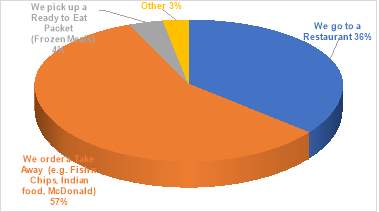
Figure 2 If you are not preparing dinner at home, what are you more likely to do?
When the meals are not cooked at home the most desirable option that consumers feel is ordering takeaway from the restaurant. The percentages of takeaway and eat in restaurants is about 93%. Most participants opt to eat takeaway or go to restaurants to eat because of a popular misconception that most people think that eating takeaways a cheaper option than cooking at home (“More than 50 per cent of Kiwis think takeaways the cheaper option”, n.d.). Only 4% opted to pick up Frozen Ready to Eat Meals.
Figure 3 Have you purchased any FROZEN READY TO EAT meals in the past month?
5.2.3 Question 3: Have you purchased any FROZEN RTE Meals in the past month?
The pie chart above depicts that 90% of respondents have purchased Frozen RTE Meals in the past month. From this question, the researcher feels that there is awareness of the frozen meals but not their first choice when determining to eat a meal. Only 10% of respondents said they had not purchased Frozen RTE Meals in the past month. However, from the research, all respondents are aware of Frozen RTE Meals that are in the market.
5.2.4 Question 4: How regularly do you purchase FROZEN RTE meals? (Please choose only ONE option)
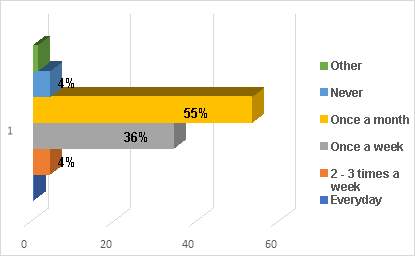
1%
0%
Figure 4 How regularly do you purchase FROZEN READY TO EAT meals?
The line chart above illustrates that 55% of respondents purchase Frozen RTE Meals once a month followed by 36% of respondents purchase them once a week. 95% of respondents buys Frozen RTE Meals regularly. From this, the researcher can conclude that Frozen Ready to Eat Meals has penetrated sufficiently in the New Zealand market. Meanwhile, the other 4% of respondents never purchase Frozen RTE Meals, and the other 1% have no opinion.
5.2.5 Question 5: If you buy FROZEN RTE meals what kind of option are you most likely to choose? (please choose just ONE option)
Figure 5 If you buy FROZEN READY TO EAT meals what kind of option are you most likely to choose?
The pie chart above explains that 63% of respondents likely to choose single meals over couple and family meals. 37% of respondents prefer a couple or family meals.
5.2.6 Question 6: If you buy FROZEN RTE meals, what type of cuisine will you choose? (Please choose just ONE option)
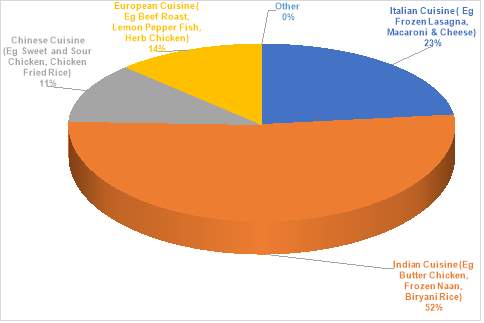
Figure 6 If you buy FROZEN READY TO EAT meals, what type of cuisine will you choose?
The pie chart above describes that 63% of respondents prefers Asian meals compared to Italian and European meals at 37%. From this survey, the researcher concluded there is a demand for Asian meals in New Zealand.
5.2.7 Question 7: Which of the following describes how you purchase FROZEN RTE Meal? (Please choose as many as apply)
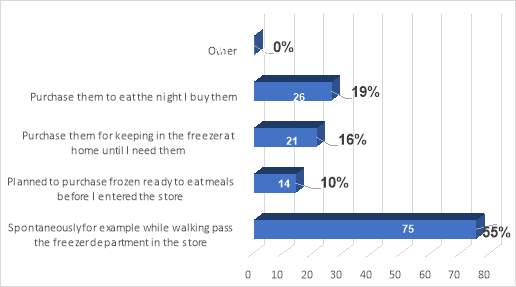
Figure 7 Which of the following describes how you purchase FROZEN READY TO EAT meal?
The line chart above illustrates that 55% of respondents spontaneously purchased Frozen RTE Meals while walking at the freezer department. 10% of the respondents plan to purchase before coming to the store. 19% or 26 respondents say that they purchase and eat the same night. Only 16% of participants buying and keep in the freezer and consume at a later time. This finding reflects the information in the literature that emphasises the importance of packaging design often has to stand for the appearance of the food itself. Moreover, the appearance and the packaging are powerful forces in customer purchase decision because the customer can see how the food looks like on the packaging. So, researcher will have a plan for this in the marketing section
5.2.8 Question 8: What is the MAIN reason you would purchase FROZEN RTE meals? (Please choose just ONE option)
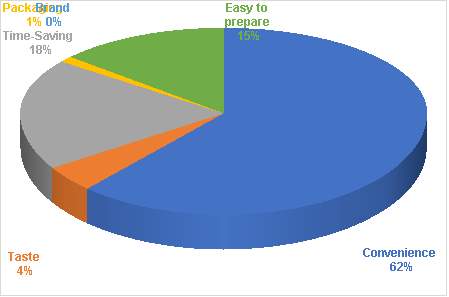
Figure 8 What is the MAIN reason you would purchase FROZEN READY TO EAT meals?
The pie chart above illustrates the main reason the respondent would purchase Frozen RTE Meals. More than 62% of respondents says convenience is their main factor in purchasing Frozen RTE Meals. 95% of respondents says time-saving, easy to prepare and convenience is the main factor. 4% of participants says the taste is the main factor and only 1% is due to packaging. From this survey, the brand is the least factor in purchasing Frozen RTE Meals This finding reflects the information in the literature that emphasises the importance of convenience as a key factor in marketing. Participants in a study by Darian (1995, pp32-44) were described as busy working people with limited time. They agreed that, working people have no time and that they buy fast foods, frozen dinners because they were convenient (Darian, 1995, pp. 32-44).
5.2.9 Question 9: Do special discounts have any effect on your purchase?
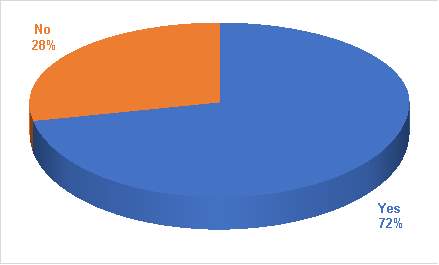
Figure 9 Do special discounts have any effect on your purchase?
The pie chart above explains that 72% of respondents says a special discount does have an impact on their decision to purchase frozen RTE; the remaining 28% felt that special offers did not have any impact on their purchasing decision. Giving a special discount does affect respondents purchase so that the researcher will have a plan for this in the marketing section. This finding reflects the information in the literature that emphasises the importance of price as a marketing tool that can be used to help attract customers, create customer satisfaction and build customer loyalty (Garton, 1995, pp. 29-35). Dawson (1995, pp. 4-20) also argues that the search for price and price comparisons are responsive to consumer buying behaviour. Kotler (2013 pp. 354-360) also pointed out that industry players would have to improve their price competitiveness significantly.
5.2.10 Question 10: How did you come to know about the FROZEN RTE meals? (choose more than one if applicable)

Figure 10: How did you come to know about the FROZEN READY TO EAT meals?
As seen from the above chart that 74% of respondents have seen the display at the supermarket has the highest visibility. Another 19% are from word of mouth from their friends. 6% of participants said they had seen TV commercials. The proposed business should leverage on display at the supermarket to increase the visibility and the penetration of the Frozen RTE Meals. From this chart, most people purchase Frozen RTE meals on the spur of the moment in the supermarket, so this finding and that earlier one reinforce the importance of catching the eye of the consumer while already in the supermarket.
5.2.11 Question 11: Kindly rate your opinion on the following parameters
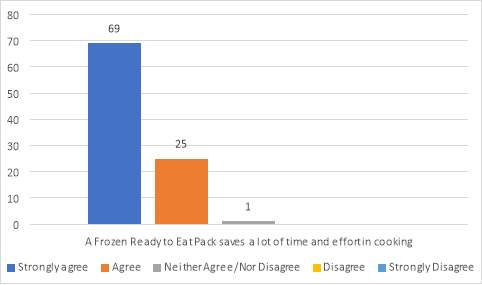 (a) A Frozen Ready to Eat Pack saves a lot of time and effort in cooking
(a) A Frozen Ready to Eat Pack saves a lot of time and effort in cooking
Figure 11 A Frozen Ready to Eat Pack saves a lot of time and effort in cooking
The bar chart above shows that 72.6% of respondents strongly agree that Frozen RTE Meals are a time-saving option from cooking, and a further 26.3% of respondents agree is a time-saving option. Only one respondent has said neither agree nor disagree. This finding reflects the information in the literature that preparation time is crucial because consumer buys Frozen RTE Meals due to convenience easy and fast to prepare. The preparation time is also a vital part of customers purchase decision because a consumer who purchases does not have the time.
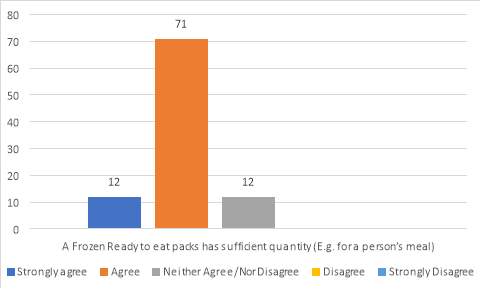 (b) A Frozen RTE packs has sufficient quantity (E.g. for a person’s meal)
(b) A Frozen RTE packs has sufficient quantity (E.g. for a person’s meal)
Figure 12 A Frozen Ready to eat packs has sufficient quantity (E.g. for a person’s meal)
As the bar chart depicts, 71 respondents agree that the Frozen RTE Meals have sufficient quantity and another 12 respondents strongly agree. Only 12 have no opinion on this matter. The general conclusion that can be drawn is that people do feel the quantity is enough for the money they are spending. From the earlier findings, most participant buys single meals, but the portion is insufficient. The researcher concluded that offering different portion sizes for example couple and family meals so that consumer will have a bigger portion.
(c) A Frozen RTE Pack is easily available whenever I need it
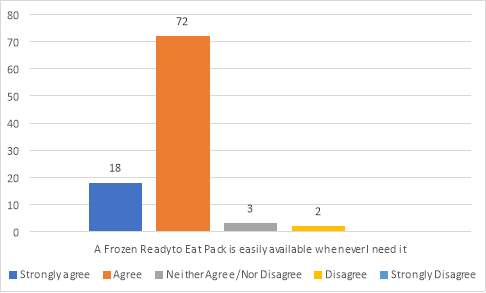
Figure 13 A Frozen Ready to Eat Pack is easily available whenever I need it
The bar chart above illustrates that 72 respondents agree and a further 18 respondents strongly agree that the Frozen RTE Pack is easily available. Only 3 have no opinion on this matter, and two respondents disagree. This shows the excellent distribution network established by Frozen RTE Meals competitors.
(d) I would purchase Frozen RTE packs if the ingredients are from New Zealand and the meal was locally produced
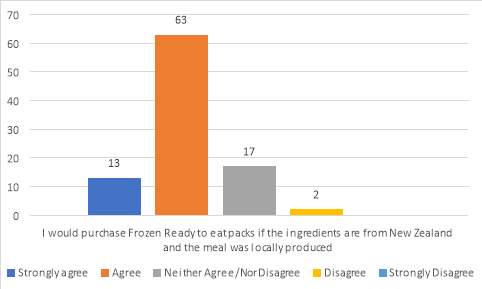
Figure 14 I would purchase Frozen Ready to eat packs if the ingredients are from New Zealand and the meal was locally produced
The bar chart above illustrates that 63 respondents agree that they would purchase if ingredients are from New Zealand and 13 respondents strongly agree. 17 respondents have no opinion on this matter, and two respondents disagree. The general conclusion that New Zealanders trust locally produced products. This could be a selling point for the researcher’s product to add value. So, the researcher will have a plan for this in the marketing section.
(e) I think a Frozen RTE packs are generally good value for money
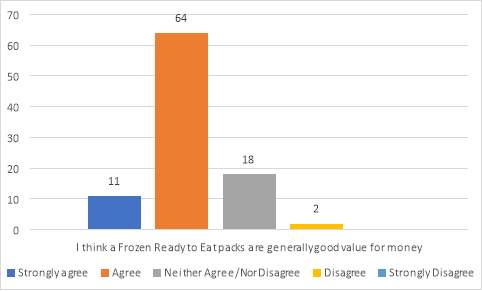
Figure 15 I think a Frozen Ready to Eat packs are generally good value for money
The bar chart above illustrates that 64 respondents agree that Frozen RTE packs are value for money and a further 11 respondents strongly agree. 18 respondents have no opinion on this matter, and two respondents disagree. Overall, 78.9% of respondents agree or strongly agree that Frozen RTE Meals are value for money that they have spent.
(f) I think that Frozen RTE meals are generally not as tasty as freshly cooked food

Figure 16 I think that Frozen Ready to Eat meals are generally not as tasty as freshly cooked food
The bar chart above demonstrates that 45 respondents have no opinion on this matter. 40 participants strongly agree or agree that Frozen RTE meals are generally not as tasty as freshly cooked. Only 10.5% of respondents disagree or strongly disagree with that statement. Most of the respondents buy Frozen RTE Meals because it is convenient, not due to the taste. Although many respondents felt that Frozen RTE meals not as tasty, this did not stop 90% buying them. The researcher has an advertising plan to show it is easy to prepare and fast.
(g) I know that the Frozen RTE Packs are manufactured with high-quality ingredients
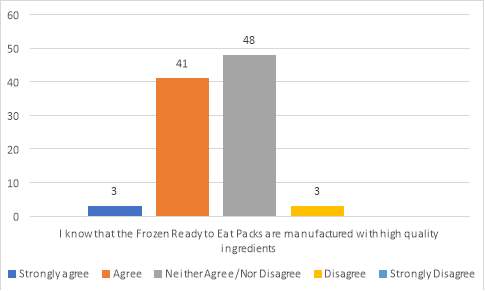
Figure 17 I know that the Frozen Ready to Eat Packs are manufactured with high-quality ingredients
As the bar chart depicts, 48 respondents have no opinion on this matter. While 44 respondents strongly agree or agree that Frozen RTE are manufactured with high-quality ingredients. Only three respondents disagree the statement. From the findings appeared to indicate that respondents are not driven to purchase by quality ingredients although they are motivated by knowing they are New Zealand made ingredients.
(g) I would definitely purchase Frozen RTE Packs if there was more variety are available in stores
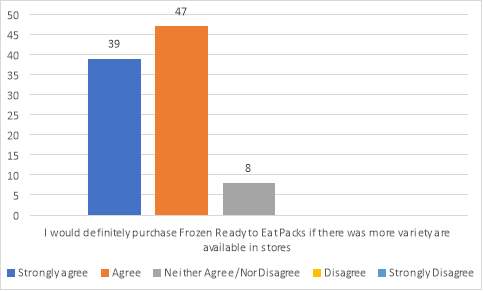
Figure 18 I would definitely purchase Frozen Ready to Eat Packs if there was more variety are available in stores
As the bar chart illustrates 86 respondents have strongly agreed or agreed that they will purchase if there is more variety in the market. Only eight respondents have no opinion on this matter. None of the respondents disagrees with this statement. The general conclusion that the proposed business must have more variety in its product line.
5.2.12 Question 12: Any suggestions or comments on FROZEN RTE Meals?
Table 1
Any suggestions or comments on FROZEN READY TO EAT Meals
| No | Comments |
| 1 | its good if they are available in more Asian food |
| 2 | would prefer if the food is more tasty |
| 3 | They are Hygienic |
| 4 | Easy to Prepare |
| 5 | Should provide more variety |
| 6 | Convenient, time-saving, variety |
The response rate on this is not good due to many respondents are rushing home or going to work while asking to do the survey. The researcher got only six response generally participants are suggesting more variety in the market, more Asian meals, it is easy to prepare, convenient and hygienic. Overall the written responses support the findings of the quantitative data about variety and convenience.
5.2.13 Question 13: Gender
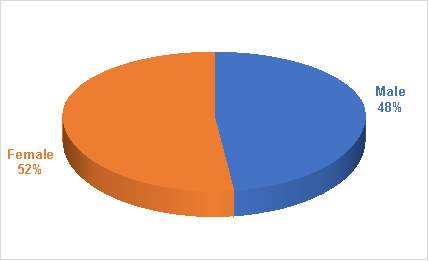
Figure 19 Gender
The pie chart illustrates the gender is almost the same amount of respondent, female at 52% compared to male at 48%. The gender was analysed to see the buying habits of Frozen RTE Meals. The survey is evenly spread between male and female, so the researcher gets a balanced output of results. The two genders have different purchasing behaviours, for example, the female is more family orientated that wants more family meals. Meanwhile, males want more single meals and fast. However, the researcher cannot come to a strong conclusion but the marketing will focus on both males and females.
5.2.14 Question 14: Age Group

Figure 20 Age Group
The pie chart illustrates the participant’s age group in the survey. The age group of the participant is evenly spread. 38% of the participant are mid-aged between 33 to 47 years old. 25% is between 48 to 62 years old. 85% of respondents are 18 to 62 years old. Only 15% is 63 and above. The researcher could not come to a strong conclusion but the marketing will focus on all age group.
5.2.15 Question 15: Who are you shopping for?

Figure 21 Are you shopping for
The pie chart illustrates 60% of respondents are shopping for their family. 31% were shopping for themselves. Only 9% for their partner or spouse. From the findings appeared to indicate that even though the majority of shoppers are family shoppers, but they buy single meals portion. This is due to lack of variety in the market for family meals.
5.2.16 Question 16: What is your average weekly income?
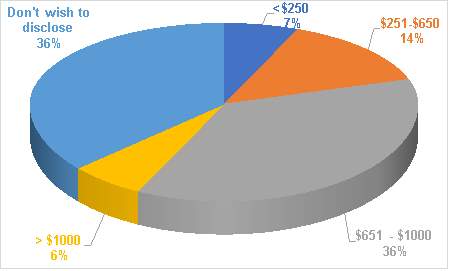
Figure 22 What is your average weekly income?
The pie chart illustrates the participant’s weekly income, about 37% is between $651-$1000. About 36% of respondent do not wish to disclose due to privacy matters. The weekly income was analysed to get the idea about the spending power of the respondents. From this question, the researcher could not come to a strong conclusion because it was quite balance but this will not affect the purchasing decision of the consumer.
5.3 Content Analysis Using Website
The purpose of using content analysis as the second data collection method was to understand the range of Frozen RTE meals sold by New Zealand supermarket. The researcher has chosen two supermarkets with a local online presence there are Countdown at https://www.countdown.co.nz and New World Levin at https://shop.newworld .co.nz/store/72C670037. The researcher prepared an Excel sheet to see the difference between Asian meals and other meals that are sold in those online stores.
5.3.1 – Eat on Existing Pack
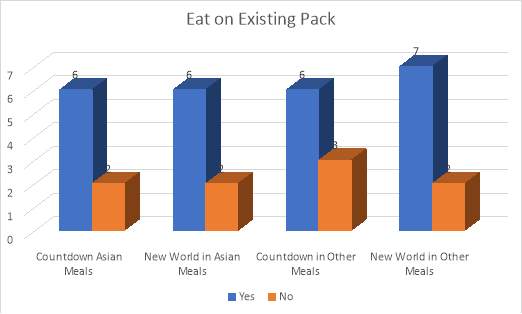
Figure 23 Eat on Existing Pack Asian and Other Meals sold at Countdown and New World Levin website content
As per the graph, the researcher has analysed Asian meals sold at Countdown and New world Levin website content as of 7th April 2017. Almost all products the consumer can eat on existing package. Asian meals at Countdown and New World are the same at six products can be eaten on the pack, and the other two have to put into another container to heat it up. From the findings appeared to indicate that eating on existing pack will be more convenient because the consumer wants it easy to prepare. The purpose of packaging is to keep food from drying out and to preserve nutritive value, flavour, texture and colour.
5.3.2 – Cooking Method
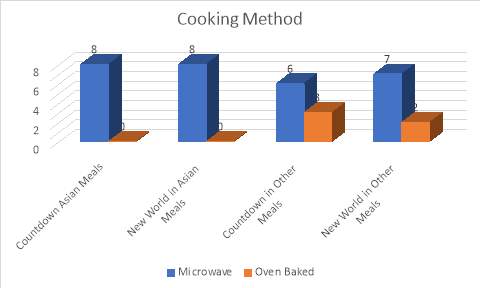
Figure 24 Cooking Method of Asian and Other Meals sold at Countdown and New World Levin website content
As the bar chart depicts the cooking method by using microwave or oven-backed of Frozen RTE Meals sold in supermarkets. All Asian meals are cooked using the microwave. This is due to the technology of packaging that consumer can be put in the microwave. The packaging is food safe and recyclable. The majority of other meals also microwaveable but some are oven baked.
5.3.3 – Halal
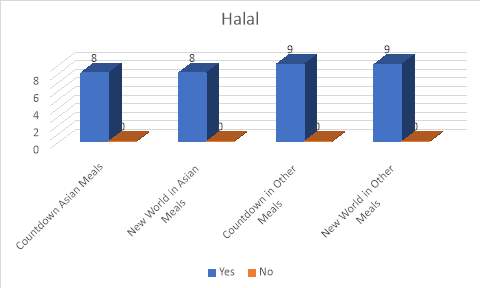
Figure 25 Halal Meals of Asian and Other Meals sold at Countdown and New World Levin website content
From the bar chart, none of the leading brands caters for Halal meals. This is something that the researcher want to add value to its customers that will be explained in length in the marketing section.
5.3.4 – Organic
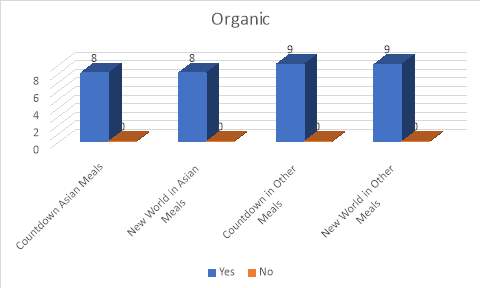
Figure 26 Organic Meals of Asian and Other Meals sold at Countdown and New World Levin website content
From the bar chart, all the products that are analysed do not provide organic meals. This is something that the researcher want to add value to its customers that will be explained in length in the marketing section.
5.3.5 – Vegetarian
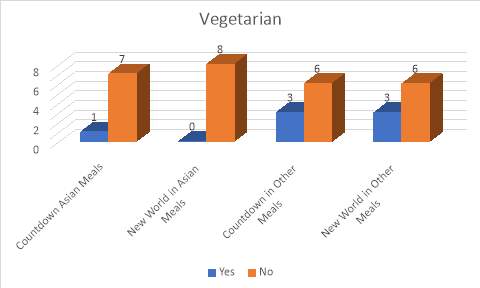
Figure 27 Vegetarian Meals of Asian and Other Meals sold at Countdown and New World Levin website content
From the bar chart, the researcher analyses that many Frozen RTE does not offer a vegetarian meal. In Countdown, there is only one product in the Asian that offer vegetarian meals. However, there is more vegetarian variety in the other meals there are three products each supermarket. From this research of the content, there is also a growing vegetarian market that the researcher can add value for its customer. Very few of the leading brands accommodates vegetarian meals.
5.3.5 – Weight Watches

Figure 28 Weight Watches Meals of Asian and Other Meals sold at Countdown and New World Levin website content
When analysed there are only two companies that promote healthy meals for example “Weight Watchers” and “Watties” in their “Meal Sensation” products. Most of the leading brand do not promote healthy meals.
5.3.6 – Country of Origin
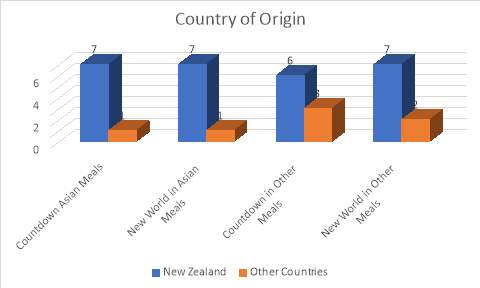
Figure 29 Country of Origin of Asian and Other Meals sold at Countdown and New World Levin website content
Most of the products are made in New Zealand, but the headquarters is from Australia for example “Watties” and “Supersnacks”.
5.3.7 – Packaging Design
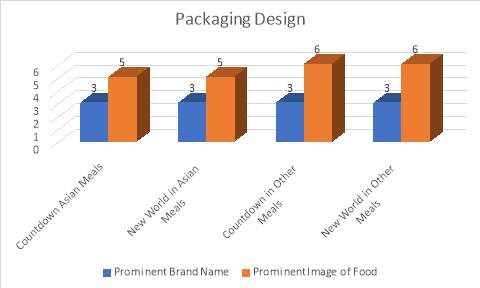
Figure 30 Packaging Design of Asian and Other Meals sold at Countdown and New World Levin website content
As for the packaging design, almost all brands show an image of food prominently on the front packaging of the products. There are only “Watties” and “Supersnacks” with prominently their brand name. The researcher will explain in length in the marketing section.
5.3.8 – Price
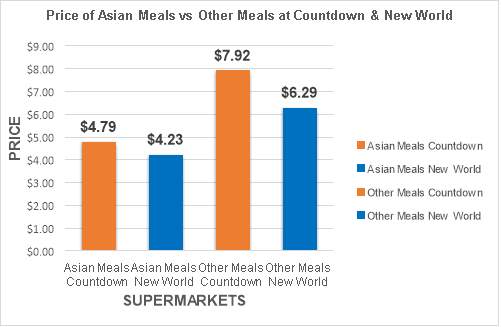
Figure 31 Price of Asian Meals vs Other Meals at Countdown & New World
The bar chart above illustrates that the average price of Asian meals at Countdown is $4.79 compared to New World is $4.23. The cost of other meals is significantly higher at $7.92 at Countdown and $6.29 in New World. This is because New World offers more family meals than in Countdown. From this analysis, the researcher found that Asian meals are generally cheaper compared to the other meals. This is due other meals have a larger quantity regarding weight and portioning than the Asian Meals.
5.3.9 – Net Weight
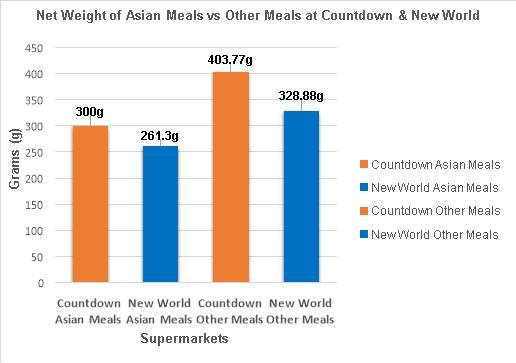
Figure 32 Net Weight of Asian Meals vs. Other Meals at Countdown & New World
The bar chart above shows that the average net weight of Asian meals in Countdown is about 300g compared to 261.3g in New World. The average net weight of other meals is significantly higher at 403.77g at Countdown and 328.88g at New World. The average net weight of Asian meals is smaller by 23.38% compared to Other meals. This is due to a larger portion of meals, for example, other meals have family meals that are intended for 3 to 4 people to eat, compared to the majority of Asian meals is for single portion meals. With this, the proposed business must have a weight that is enough for one person meal to establish the market niche.
5.3.10 – Size of Serving
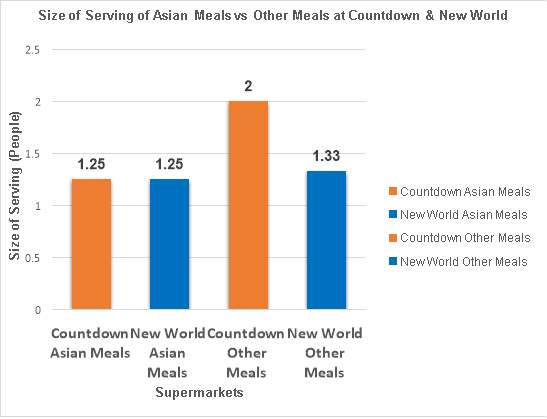
Figure 33 Size of Serving of Asian Meals vs Other Meals at Countdown & New World
The bar chart above illustrates that serving sizes for Asian meals are smaller by 24.9% on average than other flavour categories of meals. This is due to a larger portion of meals, for example, other meals have family meals that are intended for 3 to 4 people to eat, compared to the majority of Asian meals is for single portion meals.
5.3.11 – Time to Prepare
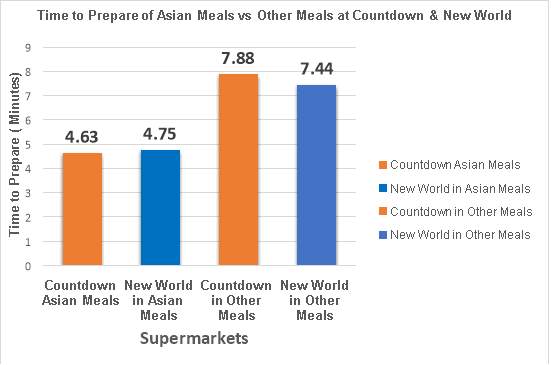
Figure 34 Time to Prepare of Asian Meals vs Other Meals at Countdown & New World
The bar chart above illustrations the time taken to prepare Asian and other meals. Asian meals at Countdown takes about 4.63 minutes to prepare compared to 4.75 minutes at New World. Time to prepare is significantly longer in other meals at 7.88 minutes at Countdown and 7.4minutes at New World. Time to prepare is an important attribute in consumer purchasing Frozen RTE Meals because it is convenient, easy to prepare and time-saving. The general conclusion is other meals have relatively a longer time to prepare because they cater for family meals that are intended for 3 to 4 people to eat, compared to the majority of Asian meals is for single portion meals.
5.4 Conclusion
From this research, it has answered a fundamental question and objectives, is there a demand or market opportunity to produce frozen RTE Asian cuisine in New Zealand. By analysing both questionnaire and the content analysis, the researcher is confident that there is a demand in Asian Frozen RTE Meals here in New Zealand. From the findings of the content analysis, there are very few options available for couple or family meals, and the findings from the questionnaire that, although a majority of participants purchase Frozen RTE Meals regularly. Nearly two-thirds purchase single meals; it shows that although there is a market potential for RTE meals for couples and families, this is not something that the majority of the market are used to purchase. Therefore, introducing this option may require the researcher to do some in-depth marketing strategies. From the analysis, the researcher’s general conclusion that there is a limited variety of Frozen RTE Meals available in the market. There is only ten brands that is sold in the local New Zealand supermarket. There must be more variety of meals sold in the frozen section of the supermarket that consumers can choose from as per the findings from questionnaire indicates. The packaging of the product must be attractive due to consumer spontaneously purchasing Frozen RTE Meals can be seen in the findings from the questionnaire. From this research, both qualitative and quantitative data validates that pricing plays a major role in customer purchasing decision, so the proposed business should have a competitive pricing to its competitors. This is because giving a special discount does affect respondents purchase decision. The majority of respondents do not think the taste is a problem. The overall results show that although many respondents felt that Frozen RTE meals are not as tasty as freshly cooked food, it did not stop the 90% of the respondent to purchase Frozen RTE Meals. The purchase decision is due to convenience, easy to prepare and fast.
Cite This Work
To export a reference to this article please select a referencing stye below:
Related Services
View allRelated Content
All TagsContent relating to: "Consumer Decisions"
The consumer decision making process involves how consumers identify their needs and gather and process information prior to a purchase. Consumer decisions involve how the emotions and preferences of consumers can impact their buying decisions.
Related Articles
DMCA / Removal Request
If you are the original writer of this dissertation and no longer wish to have your work published on the UKDiss.com website then please:

